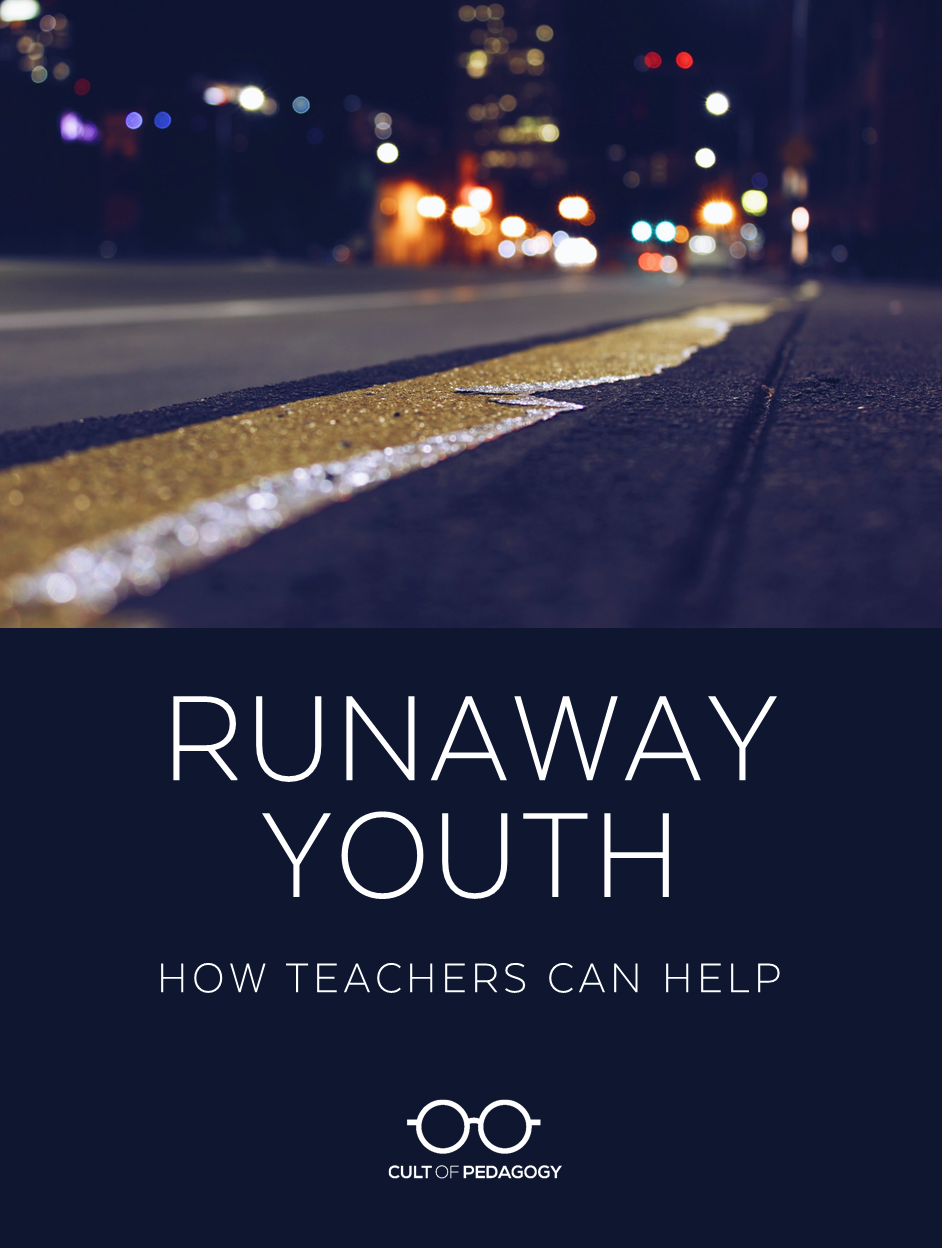
Listen to my interview with Maureen Blaha, Executive Director of the National Runaway Safeline (transcript):
Because our mission is to serve and teach kids, any issue that impacts them has the potential to impact our work. And running away from home can impact kids in dangerous ways. We owe it to them to understand the scope of the problem, learn how to spot and respond to the warning signs of running away, and familiarize ourselves with the resources that can help.
One of those resources is the National Runaway Safeline (NRS), a nationwide communication system to serve the needs of runaway and homeless youth. Executive Director Maureen Blaha talked with me about the runaway problem in the U.S. and how teachers can play a more active role in solving it.
How Serious is the Runaway Problem?
If you’re like me and don’t know anyone who has run away from home, you may not realize how significant the runaway problem is. According to the NRS, between 1.6 and 2.8 million youth run away from home each year in the U.S. Although these numbers are striking on their own, they don’t tell the whole story. The ways running away can change a child’s life are serious and sometimes frightening: Running away is correlated with significantly lower high school graduation rates, greater misuse of prescription drugs, and crime.

Maureen Blaha
“Initially they become really susceptible to being victims of crime,” Blaha explains. “They’re afraid, they’re alone, they’re on the streets. Obviously they kind of stick out like a sore thumb, and they become victims of crime.”
If the youth returns home quickly and no more episodes occur, that may be the extent of it. But if the youth stays away, crime can become a way of life. “After awhile,” Blaha continues, “in order to survive, they become perpetrators of crime: panhandling, maybe dealing drugs, oftentimes they get recruited into the human trafficking vortex.” The National Alliance to End Homelessness estimates that every year over 100,000 children are victims of commercial sexual exploitation–the most common kind of human trafficking in the U.S. Many of these children are runaway or homeless youth.
It goes without saying that if we can help prevent episodes of running away, we can also stave off a whole host of other serious consequences.
Warning Signs, and How to Respond
Youth who are considering running away often display a similar set of behaviors prior to taking action. If teachers can be more tuned in to these behaviors, we may be able to prevent a child from running away. Here are some signs to look out for:
- Changes in behavior patterns: eating or sleeping significantly more or less than usual, unusual mood swings, or spending noticeably more time alone in their room or out of the house.
- A drop in grades, an increase in truancy or absences, or rule breaking that is not typical for that youth.
- Accumulation of money or possessions; this could be a sign that the youth is gathering resources for when they are away from home.
- Actually referencing wanting to run away by saying things like “I have to get out of that place” or threatening to run away. These comments should be taken seriously.
If you notice these kinds of behaviors in one of your students, do not ignore them. Instead, speak with a guidance counselor, administrator, or both about what you’re noticing. If there is any suspicion of abuse going on in the home, teachers have a duty to report this.
After talking to guidance and administration, talk with the student. Describe the changes you’ve noticed, express your concern, and offer to set up an appointment with a counselor. If the student is, in fact, considering running away, provide them with information about the resources below, where trained professionals can help the student find the best resolution to their problem.
How the National Runaway Safeline Helps Runaways
The NRS offers a comprehensive set of resources to help those who have run away or who are considering it. By making this information available to students and families through the NRS’s free promotional materials, teachers will ensure that more people take advantage of these services if and when they need them.
- Constant access to the NRS staff through 24-hour toll-free phone hotline, a highly responsive email system, a live online chat program, and an online forum, where visitors can post questions and get advice from NRS staff within a few hours.
- A national database of shelters where NRS staff can help youth find safe places to stay.
- Communication services to help students safely contact parents include conference calls, where an NRS staff member is on the call the whole time with the youth and their parent, and a messaging service, which allows the runaway to send a message through NRS without having to talk directly to parents.
- NRS’s Home Free program, in partnership with Greyhound Bus Lines, provides free bus tickets to return youth to a parent or guardian. This is available to youth all the way up to age 21.
- The Let’s Talk: Runaway Prevention Curriculum is a 14-module, evidence-based curriculum offered free to educators. “It’s intended to build life skills and help young people learn how to resolve problems without resorting to running away or getting engaged in unsafe behavior,” says Blaha.
Although the relationship between parents and their children is ultimately the main factor in the decision to run away, educators can have an influence by paying close attention to changes in student behavior and keeping the community informed about the resources that can help.
If you are thinking about running away from home or know someone who is, contact the National Runaway Safeline at 1-800-RUNAWAY.
Join my mailing list and get weekly tips, tools, and inspiration—in quick, bite-sized packages—all geared toward making your teaching more effective and fun. You’ll also get access to my members-only library of free downloadable resources, including my e-booklet, 20 Ways to Cut Your Grading Time in Half, which has helped thousands of teachers spend less time grading!




